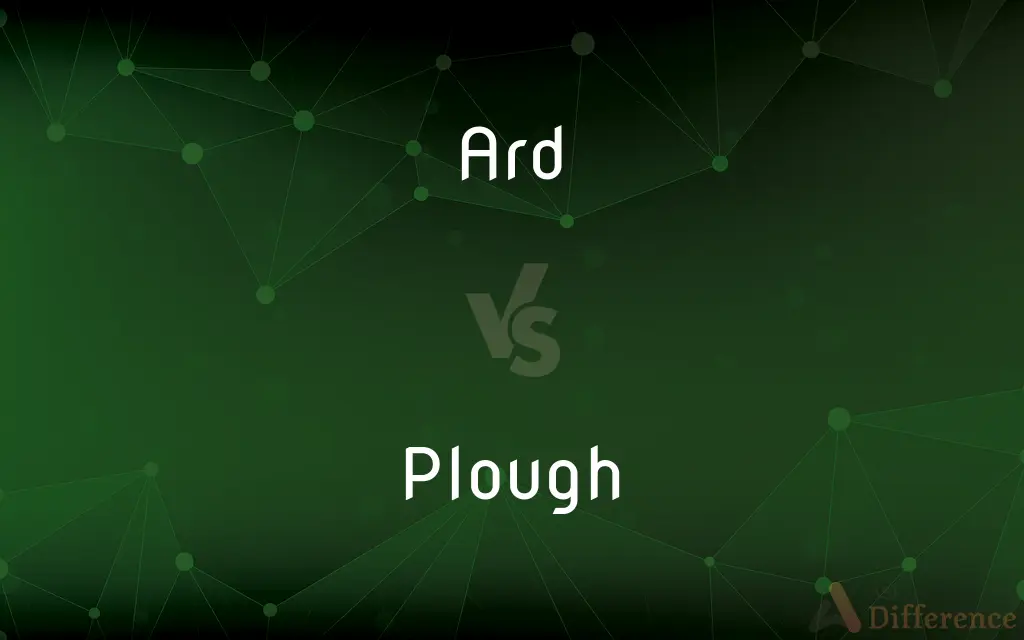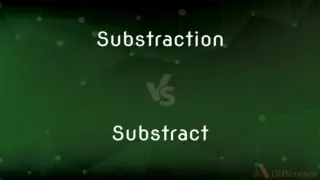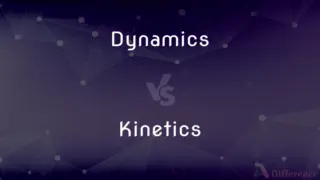Ard vs. Plough — What's the Difference?
By Maham Liaqat & Fiza Rafique — Updated on April 6, 2024
Ard is an ancient, light ploughing tool, while a plough is a more complex farming implement for turning soil.

Difference Between Ard and Plough
Table of Contents
ADVERTISEMENT
Key Differences
An ard, also known as a scratch plough, is a simple, early form of plough primarily used for shallow ploughing, preparing the soil for sowing by scratching the surface. It is one of the oldest agricultural tools, consisting of a frame holding a vertical wooden spike that scratches the soil. This tool was suitable for the light, sandy soils of the regions where it was originally used. In contrast, a plough is a more advanced and robust agricultural implement designed for cutting, lifting, and turning over soil layers to prepare for sowing seeds. Modern ploughs are equipped with multiple blades or mouldboards and are often tractor-drawn, capable of handling a variety of soil types, including heavy clay soils.
The ard is considered to be more primitive and less efficient than the plough, as it does not turn the soil over or create furrows as effectively. This limitation makes the ard less suitable for heavier soils or for preparing land that has not been previously cultivated. On the other hand, the plough, with its ability to invert the soil and bury crop residues and weeds, is more effective for soil aeration, moisture retention, and preparing a seedbed, making it a vital tool in modern agriculture.
The ard was used in ancient civilizations before the development of the plough. Its simplicity and the minimal disturbance it caused to the soil made it ideal for the early stages of agriculture. The transition to the plough represented a significant agricultural advancement, allowing for more intensive farming and the cultivation of a wider range of environments. This transition was crucial for the development of agricultural societies and the support of larger populations.
Despite its simplicity, the ard has played a significant role in the history of agriculture, enabling early farmers to make the first steps toward cultivating the earth and supporting the growth of civilizations. Meanwhile, the development and refinement of the plough have continued over centuries, with modern versions incorporating advanced materials and technology to increase efficiency and reduce labor.
The choice between an ard and a plough depends on the specific agricultural needs, soil type, and the scale of farming. While the ard has largely been replaced by more sophisticated ploughing tools in most parts of the world, its historical importance and efficiency in certain conditions are acknowledged.
ADVERTISEMENT
Comparison Chart
Definition
A simple, ancient ploughing tool for scratching the soil surface.
A farming implement for cutting, lifting, and turning soil.
Complexity
Primitive and less efficient; suitable for light, sandy soils.
More advanced, capable of handling a variety of soil types.
Soil Turnover
Does not turn the soil over; mainly scratches the surface.
Effectively turns the soil over, preparing it for sowing.
Usage
Used in ancient civilizations for shallow ploughing.
Used in modern agriculture for intensive farming.
Historical Role
Enabled early agriculture by making the first steps toward soil cultivation.
Represented a significant advancement in farming technology.
Compare with Definitions
Ard
An ancient farming tool for lightly scratching the soil surface.
The ard was essential for early farmers cultivating light and sandy soils.
Plough
Equipped with multiple blades or mouldboards for effective soil turnover.
Modern ploughs, with their multiple blades, can prepare fields quickly for the planting season.
Ard
Primarily used for shallow ploughing and preparation of soil for sowing.
Using an ard, the farmer prepared the field by creating shallow lines for planting.
Plough
A farming implement designed for cutting, lifting, and turning over soil.
The plough dramatically increased the efficiency of preparing land for cultivation.
Ard
Largely replaced by more efficient ploughing tools in modern farming.
While the ard served its purpose in ancient times, it has been largely superseded by the plough.
Plough
Continues to evolve with advancements in materials and technology.
Today's ploughs incorporate advanced technology for greater efficiency and ease of use.
Ard
Characterized by its simplicity and minimal soil disturbance.
The minimal disturbance caused by the ard was suitable for early agricultural practices.
Plough
Used in a variety of soil types, including heavy clay soils.
Unlike the ard, the plough can handle the challenging heavy clay soils of the region.
Ard
Remains a symbol of early agricultural innovation and development.
The ard represents an important step in the evolution of agricultural tools and techniques.
Plough
Represents a significant advancement in agricultural technology.
The introduction of the plough was a turning point in the history of agriculture.
Ard
A simple plough consisting of a spike dragged through the soil.
Plough
A plough or plow (US; both ) is a farm tool for loosening or turning the soil before sowing seed or planting. Ploughs were traditionally drawn by oxen and horses, but in modern farms are drawn by tractors.
Plough
A farm implement consisting of a strong blade at the end of a beam, usually hitched to a draft team or motor vehicle and used for breaking up soil and cutting furrows in preparation for sowing.
Plough
An implement or machine designed to move earth, snow, or other material by means of a strong blade.
Plough
Plow See Big Dipper.
Plough
To break and turn over (earth) with a plow.
Plough
To form (a furrow, for example) with a plow.
Plough
To form furrows in with a plow
Plow a field.
Plough
To form wrinkles or creases in
His forehead was plowed with lines of stress.
Plough
To move or clear (snow, for example) by means of a plow.
Plough
To clear (an area) of snow or other material by means of a plow.
Plough
To make or form with driving force
I plowed my way through the crowd.
Plough
To progress through (water)
Plow the high seas.
Plough
Vulgar Slang To have intercourse with (another). Used of a man.
Plough
To break and turn up earth with a plow.
Plough
To move or clear material such as snow with a plow.
Plough
To admit of plowing
Rocky earth plows poorly.
Plough
To move or progress with driving force
The ball carrier plowed through the defensive line.
Plough
To proceed laboriously; plod
Plowed through the backlog of work.
Plough
A device pulled through the ground in order to break it open into furrows for planting.
The horse-drawn plough had a tremendous impact on agriculture.
Plough
The use of a plough; tillage.
Plough
Alt form|en|Plough}} ({{synonym of Ursa Major)
Plough
Alternative form of ploughland, an alternative name for a carucate or hide.
Plough
A joiner's plane for making grooves.
Plough
A bookbinder's implement for trimming or shaving off the edges of books.
Plough
(yoga) A yoga pose resembling a traditional plough, halāsana.
Plough
(transitive) To use a plough on soil to prepare for planting.
I've still got to plough that field.
Plough
(intransitive) To use a plough.
Some days I have to plough from sunrise to sunset.
Plough
To move with force.
Trucks ploughed through the water to ferry flood victims to safety.
Plough
To furrow; to make furrows, grooves, or ridges in.
Plough
(nautical) To run through, as in sailing.
Plough
(bookbinding) To trim, or shave off the edges of, as a book or paper, with a plough.
Plough
(joinery) To cut a groove in, as in a plank, or the edge of a board; especially, a rectangular groove to receive the end of a shelf or tread, the edge of a panel, a tongue, etc.
Plough
To fail (a student).
Plough
See Plow.
Plough
A group of seven bright stars in the constellation Ursa Major
Plough
A farm tool having one or more heavy blades to break the soil and cut a furrow prior to sowing
Plough
Move in a way resembling that of a plow cutting into or going through the soil;
The ship plowed through the water
Plough
To break and turn over earth especially with a plow;
Farmer Jones plowed his east field last week
Turn the earth in the Spring
Common Curiosities
What is the main difference between an ard and a plough?
The main difference is their complexity and efficiency; the ard is simpler and less efficient, suitable for light soils, while the plough is more advanced, turning the soil over for a variety of soil types.
Why was the ard important in ancient agriculture?
The ard was important for its simplicity and minimal soil disturbance, making it suitable for the early stages of agriculture.
Can modern ploughs handle different types of soil?
Yes, modern ploughs are designed to handle a wide range of soil types, including heavy clay soils.
Can an ard turn the soil over like a plough?
No, an ard primarily scratches the surface without turning the soil over, unlike a plough which can effectively invert the soil.
Has the ard been completely replaced by the plough?
In most parts of the world and for intensive farming, yes, the ard has been largely replaced by the plough, although it may still have uses in certain conditions.
What advancements have been made in plough technology?
Advancements include the use of durable materials, design improvements for better soil turnover, and compatibility with modern tractors for increased efficiency.
Why is soil turnover important in agriculture?
Soil turnover is crucial for burying crop residues and weeds, aerating the soil, and preparing a suitable seedbed for planting.
How has the plough evolved over time?
The plough has evolved from simple wooden implements to sophisticated tools incorporating advanced materials and technology for increased efficiency.
Is there any place where ards are still used today?
While rare, ards may still be used in some regions for specific conditions or for traditional farming practices.
Do both ards and ploughs require animals or machinery to operate?
Historically, both were pulled by animals, but modern ploughs are often drawn by tractors, whereas ards, being much simpler tools, require less force and can be animal-drawn or hand-operated in some cases.
Share Your Discovery

Previous Comparison
Substraction vs. Substract
Next Comparison
Dynamics vs. KineticsAuthor Spotlight
Written by
Maham LiaqatCo-written by
Fiza RafiqueFiza Rafique is a skilled content writer at AskDifference.com, where she meticulously refines and enhances written pieces. Drawing from her vast editorial expertise, Fiza ensures clarity, accuracy, and precision in every article. Passionate about language, she continually seeks to elevate the quality of content for readers worldwide.














































